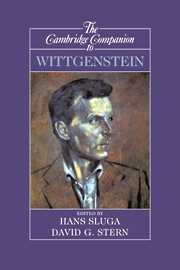Book contents
- Frontmatter
- Ludwig Wittgenstein
- 1 Wittgenstein's critique of philosophy
- 2 Pictures, logic, and the limits of sense in Wittgenstein's Tractatus
- 3 Fitting versus tracking
- 4 Philosophy as grammar
- 5 A philosophy of mathematics between two camps
- 6 Necessity and normativity
- 7 Wittgenstein, mathematics, and ethics
- 8 Notes and afterthoughts on the opening of Wittgenstein's Investigations
- 9 Mind, meaning, and practice
- 10 “Whose house is that?” Wittgenstein on the self
- 11 The question of linguistic idealism revisited
- 12 Forms of life
- 13 Certainties of a world-picture
- 14 The availability of Wittgenstein's philosophy
- Bibliography
- Index
2 - Pictures, logic, and the limits of sense in Wittgenstein's Tractatus
Published online by Cambridge University Press: 28 May 2006
- Frontmatter
- Ludwig Wittgenstein
- 1 Wittgenstein's critique of philosophy
- 2 Pictures, logic, and the limits of sense in Wittgenstein's Tractatus
- 3 Fitting versus tracking
- 4 Philosophy as grammar
- 5 A philosophy of mathematics between two camps
- 6 Necessity and normativity
- 7 Wittgenstein, mathematics, and ethics
- 8 Notes and afterthoughts on the opening of Wittgenstein's Investigations
- 9 Mind, meaning, and practice
- 10 “Whose house is that?” Wittgenstein on the self
- 11 The question of linguistic idealism revisited
- 12 Forms of life
- 13 Certainties of a world-picture
- 14 The availability of Wittgenstein's philosophy
- Bibliography
- Index
Summary
Wittgenstein's enigmatic conception of sentences as pictures and his attempt to recast logic in essentially truth-functional terms have long fascinated readers of the Tractatus. I hope in this essay to clarify the content and motivation of Wittgenstein's view of sentences as pictures and to relate this conception to his views on logic. At the beginning of the foreword to the Tractatus, Wittgenstein tells his readers that the Tractatus is not a textbook, that perhaps only someone who has had the thoughts it expresses will understand it. The foreword also suggests that the Tractatus is in large measure a response to and critique of Frege's and Russell's views. My strategy then is to examine how aspects of the Tractatus emerge against the backdrop of problems that Frege's and Russell's views posed for Wittgenstein.
THE OLD LOGIC
Wittgenstein rejected Frege's and Russell's universalist conception of logic - what he disparaged as the old logic - while retaining their inchoate but guiding assumptions first that logic frames all thought, and second that it is possible to give a clear, completely explicit, and unambiguous expression to the contents judged true or false. To begin with, let us survey some of the leading features of the old logic and then consider briefly some of Wittgenstein's dissatisfactions with it.
- Type
- Chapter
- Information
- The Cambridge Companion to Wittgenstein , pp. 59 - 99Publisher: Cambridge University PressPrint publication year: 1996
- 40
- Cited by



